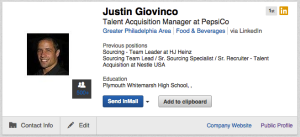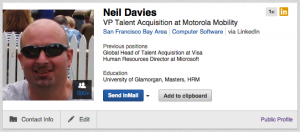If you’re not getting the response you want from your InMails, the problem could be as simple as your subject line.
With LinkedIn again tightening up the consequences for InMails that go ignored, improving your response rate is not only good for your sourcing, but good for your wallet. You don’t want to get burned by LinkedIn for getting negative feedback on InMails, and you certainly don’t want to repel potential candidates by reaching out to them in ways they don’t appreciate.
With this in mind, I’d like to share some methods that have worked for me.
The InMails and emails that follow are recent outreach success stories I’ve had. Since reactivating my LinkedIn Recruiter account in August, I’ve sent 649 InMails, 638 of which have positive responses.
Let’s begin.

Justin Giovinco’s LinkedIn profile recently came to my attention.
I felt Giovinco, a talent acquisition manager for PepsiCo, might be someone worth knowing. A review of his work history revealed his career included work at companies like HJ Heinz, Nestle, and Kaiser Permanente. I decided to reach out, so scanned his profile for clues to the best way to initiate conversation. Under Education, I discovered he was co-captain of the varsity wrestling team in college.
This information was used in my InMail subject line.
When Giovinco opened my message, the first lines he saw were,
I’m only half serious. You can ignore that question, since my primary purpose was to get you to read my InMail instead of deleting it along with the dozens of others we all choose to ignore.
Giovinco’s response was positive. He and I scheduled a call and had a great conversation.
 Another success story is my interaction with Jill Riopelle from Airbnb. She’s been with the company quite a while and is currently their head of recruiting.
Another success story is my interaction with Jill Riopelle from Airbnb. She’s been with the company quite a while and is currently their head of recruiting.
I reviewed her profile and looked for interesting conversation starters. She speaks Italian and French; she studied international affairs; she’s received a handful of recommendations. None of this struck me as something I wanted to use as an icebreaker. Then one of her previous employers gave me an “ah-ha” moment. The very name Backroads triggered memories of my recent backpacking trip in Asia, and since Jill works for Airbnb, a company strongly linked to travel, I decided to go with a backpacking type subject line. I hunted down her email address and sent over a message.
![]() In the body of the message I mentioned that my buddies and I used Airbnb while we were in Thailand. The first line of her reply was, “Great subject line – I can clearly see your recruiting roots.”
In the body of the message I mentioned that my buddies and I used Airbnb while we were in Thailand. The first line of her reply was, “Great subject line – I can clearly see your recruiting roots.”
My last example is my communication with VP Talent Acquisition at  Motorola Mobility, Neil Davies.
Motorola Mobility, Neil Davies.
His LinkedIn profile details an interesting and progressive career path.
I decided to use his unique employers in my subject line. Keep in mind: subject lines don’t need to completely make sense or be based entirely in reality. Your goal is to get the recipient to open your message. I sent this: 
The first line he saw when he opened the note was: “My apologies for the cheesy opener, but I wanted to get your attention.”
His response?
Great subject line that did catch my attention. I’d be happy to connect. I’m around next week, give me a call.
I can’t stress enough how valuable customized messaging is to establishing relationships and building rapport. Experiment. Try new things. Realize that you cannot and will not win every single person every single time, but also realize that when you look and sound like every other recruiter out there, a person’s urge to interact with you will be small, if there is any urge at all.
Happy hunting.
